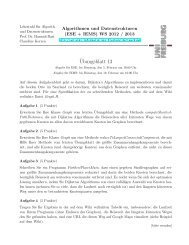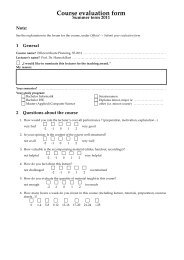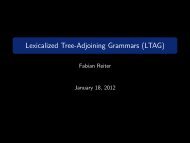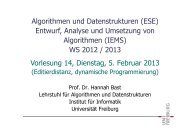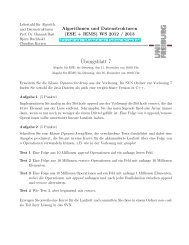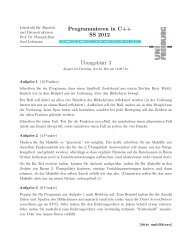Information Retrieval - ad-teaching.infor...
Information Retrieval - ad-teaching.infor...
Information Retrieval - ad-teaching.infor...
You also want an ePaper? Increase the reach of your titles
YUMPU automatically turns print PDFs into web optimized ePapers that Google loves.
<strong>Information</strong> <strong>Retrieval</strong>WS 2012 / 2013Lecture 8, Wednesday December 12 th , 2012(Synonyms, Latent Semantic Indexing)Prof. Dr. Hannah BastChair of Algorithms and Data StructuresDepartment of Computer ScienceUniversity of Freiburg
Overview of this lecture• Organizational– Your experiences with ES#7 (cookies, UTF-8)– Date for the exam !• Synonyms– Automatic approach: latent semantic indexing (LSI)– Based on singular value decomposition (SVD) of theterm-document matrix– Effectively compute pairs of related terms– Exercise Sheet 8: create term-document matrix fromour example collection, and get related terms via LSI
Experiences with ES#7 (cookies, UTF-8)• Summary / excerpts last checked December 12, 15:54– Confusion in Java, some file re<strong>ad</strong>ers autocorrect the UTF-8– Some problems with Cookies and file://...– Subscribe to the Announcements subforum, then you will getan email when something is posted thereActually: best to subscribe to all subforums (one per ES)– "UTF-8 is a great topic ... lost my fear of text encoding issues"– Web stuff nice to look at, but not so nice to actually build it– Master solution for the chocolate chip cookies please– Last sheets took much longer than 8 hours, please reduceI will do my best ... but please don't forget that most of theovertime is due to lack of programming skills / experience3
Results for ES#6+7 (web apps)• Let's look at some of the web apps– Suggestions also for multiple keywords– Result snippets– Nice layout– Postponed to next lecture …4
Synonyms 1/4• Problem: another source of word variation– We have alre<strong>ad</strong>y seen prefix searchType uni ... find university– And error-tolerant searchType uniwercity ... find university– But sometimes there are simply totally different wordsexpressing more or less the same thingType university ... find collegeType bringdienst ... find lieferserviceType cookie ... find biscuit5
Synonyms 2/4• Solution 1: Maintain a thesaurus– Hand-maintain a thesaurus of synonymsuniversity: uni, ac<strong>ad</strong>emy, college, ...bringdienst: lieferservice, heimservice, pizzaservice, ...cookie: biscuit, confection, wafer, ...– Problem 1: laborious, yet notoriously out of date– Problem 2: it depends on the context, whichsynonyms are appropriateuniversity award ≠ ac<strong>ad</strong>emy awardhttp cookie ≠ http biscuit– Anyway, that's not the topic of today's lecture ...6
Synonyms 3/4• Solution 2: Track user behaviour– Investigate not just individual searches but wholesearch sessions (tracked using, guess what, cookies):The initial queryThe subsequent queriesWhat the user eventually clicked on– Interesting, but not the topic of today's lecture either ...7
Synonyms 4/4• Solution 3: Automatic methods– The text itself also tells us which words are related– For example: pizza delivery webpagesthey have similar contents (and style)some use the word Bringdienstsome use the word Lieferservice– Latent Semantic Indexing (LSI) tries to find suchrelations, based on similar context, automatically– This is the topic of today's lecture !8
Latent Semantic Indexing 1/9• An example term-document matrix9
Latent Semantic Indexing 2/9• Assume our matrix is a product of these two• This is a matrix with column rank 2– column rank = all columns can be written as a linearcombination of that many "base" columns, but not less– row rank = defined analogously10– Theorem: column rank = row rank
Latent Semantic Indexing 3/9• If we change only few entries in that matrix– we obtain a full-rank matrix again ... check in Octave– Let us assume that the matrix came from a rank-2matrix by changing only a few entries ... which it did– Then it's not hard to guess that rank-2 matrix here–LSIdoes this recovering automatically11
Latent Semantic Indexing 4/9• Definition of Latent Semantic Indexing (LSI)– Given an m x n term-document matrix A– And a rank k, typically
Latent Semantic Indexing 5/9• Eigenvector decomposition (EVD)– For an m x m matrix A, and an m x 1 vector xwe say that x is an eigenvector of A if A · x = λ · xλ is called an Eigenvalue of A– If A is symmetric, A has m linear independenteigenvectors, which hence form a basis of the R m– Then A can be written as U · D · U Twhere D is diagonal, containing the Eigenvaluesand U is unitarian, that is, U · U T = U T · U = I– This is called the Eigenvector decomposition of Asometimes also called Schur decomposition13
Latent Semantic Indexing 6/9• Singular Value Decomposition (SVD)– Let A be an arbitrary rectangular m x n matrix A– Then A can be written as U · ∑ · V Twhere U is m x k, ∑ is k x k, and V is n x k k = rank(A)and U T · U = I and V T · V = I (but not vice versa !)and ∑ is a diagonal matrix with the so-called singularvalues on its diagonal– Let's look at an example in Octave ...15
Latent Semantic Indexing 8/9• With the SVD, rank-k approximation becomes easy– For a given m x n matrix A, compute SVD A = U · ∑ · V T– Let U k = the first k columns of U– Let Σ k = the upper k x k part of ∑– Let V k = the first k columns of V– Then AA = U k · Σ k · V T k is the desired approximationthat is, that rank-k matrix A k which minimizes ǁ A – A k ǁ– Let's look at our example in Octave ...17
Octave 1/5• Script language for numerical computation– GNU's open source version of the proprietary Matlab– Makes numerical computations easy, which wouldotherwise be a pain to use in Java / C++In particular: comp. involving matrices and vectors– Also comes with an interactive shell ... see next slilde– Language has C-like commands (printf, fopen, ...)– Still it's a script language, and correspondingly slow– The built-in functions (like svd) are fast though– Downlo<strong>ad</strong> and Doc.: http://www.gnu.org/software/octave19
Octave 2/5• Use the Octave shell pretty much like a Bash shell– Arrow : previous command– Arrow : next command–CTRL+R: search in history–CTRL+A: go to beginning of line–CTRL+E: go to end of line–CTRL+K: delete from cursor position to end of line20
Octave 3/5• Here are some commands useful for ES#8– Create a vector or matrixA = [1 1 1 0 0; 0 0 1 2 0; 1 0 0 1 1]; // 3 x 5 matrix.– Compute part of SVD pertaining to k top singular values21[U, S, V] = svd(A);[U, S, V] = svds(A, k);– Get a portion of a matrix or vectorUU = U(:, 1:k); // First k columns of U.– Multiply a matrix with its transposeT = UU * UU';// For dense matrices, k = rank(A)// For sparse matrices, must spec. k– Note: if you omit the semicolon or write a comma, the resultwill be printed on the screen
Octave 4/5• Sparse matrices– Our term-document matrices are very sparse, that isnnz
Octave 5/5• Vectors of strings– Re<strong>ad</strong> file with one string per line into Octave like thisA = {};file = fopen("words.txt");i = 1;while trueline = fgetl(file);if line == -1, break; endif;A(1, i) = line;i++;endwhile– With Octave version ≥ 3.4, easier with textre<strong>ad</strong> ...23
References• Further re<strong>ad</strong>ing– Textbook Chapter 18: Matrix decompositions & LSIhttp://nlp.stanford.edu/IR-book/pdf/18lsi.pdf– Deerwester, Dumais, Landauer, Furnas, HarshmanIndexing by Latent Semantic Analysis, JASIS 41(6), 1990• Wikipedia– http://en.wikipedia.org/wiki/Latent_semantic_indexing– http://en.wikipedia.org/wiki/Singular_value_decomposition– http://www.gnu.org/software/octave– http://en.wikipedia.org/wiki/GNU_Octave24



